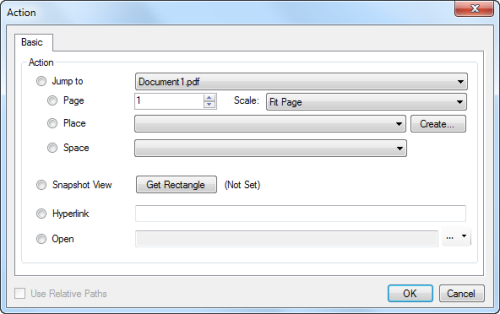Go to Markup > ![]() Hyperlink to view the hyperlinks in the current PDF. Hyperlinked areas of the PDF are highlighted in blue.
Hyperlink to view the hyperlinks in the current PDF. Hyperlinked areas of the PDF are highlighted in blue.

To turn off the Hyperlinks view, press ESC.
The Hyperlink tool is used to insert and view hyperlinks in a PDF. Once placed, a hyperlink will perform its defined action when clicked. When that action is to open another PDF, clicking the hyperlink will open the document in the foreground and CTRL-clicking the hyperlink will open it in the background.
For batch hyperlinking, see Batch Link (only available in Bluebeam Revu eXtreme Edition).
Go to Markup > ![]() Hyperlink to view the hyperlinks in the current PDF. Hyperlinked areas of the PDF are highlighted in blue.
Hyperlink to view the hyperlinks in the current PDF. Hyperlinked areas of the PDF are highlighted in blue.

To turn off the Hyperlinks view, press ESC.
To add a hyperlink to a defined area:
To add a hyperlink to text:
Hyperlinks can also be created from the Hyperlink button in the File Access list:
Hyperlinks can also be created from Search Results.
The Hyperlink Action is what will happen when the hyperlink is clicked. This is defined in the Action dialog box, which appears after the hyperlinked area or text is defined.

There are
Jump to Page: Moves to a specific page number in a selected PDF. To set this action:
Jump to Place: Moves to a predefined Place on a PDF. The location of a Place can be changed later without breaking the action. To set this action:
Jump to Space: Moves to a predefined Space on a PDF. To set this action:
Note: If an Action is set to jump to a Space that is subsequently deleted, the Action will be automatically converted to Snapshot View, as described below.
Snapshot View: Moves to a specific, zoomed in area of the current PDF. This option is useful for zooming into specific views of a region of a large format drawing, such as a particular elevation detail. Click Get Rectangle to define the area of the drawing to jump to.
Hyperlink: Opens the URL entered in the Hyperlink field. The URL will open in
Open: Opens the file specified in the Open File field. Click  button
button
Use Relative Paths: Revu can store either a full or relative path to a file. When a full path is stored, the location of the file is defined from the drive it resides on; when a relative path is stored, it defines the location of the linked file relative to the current file. A full path is best when you plan to move the file storing the link but not the file being linked to, such as when the linked file resides on a network drive that is accessible to all users. A relative path is best when both files are liable to be moved, such as when you are archiving an entire project to CD, or moving a project to another computer. For more information and Relative vs Full Path, see Understanding Relative vs Full Paths.
A link to a Snapshot view in another PDF can be created using the following steps: